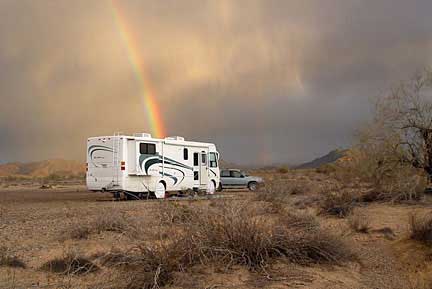Yellowstone and South Dakota
Yellowstone
We returned to Yellowstone after an absence of seven years and found some changes. For starters there were a lot more tourists. After Labor Day it used to be pretty quiet and we were able to get into the campgrounds without reservations. This year the campgrounds were full. Fortunately we knew of a nice Forest Service campground just north of West Yellowstone and got a space there for a few days until we could get a site in the park.


The elk population was also down compared to our earlier visits. We did not find the large herds around Madison and Norris that we had seen on past visits. One theory was that they had migrated to higher country because it had been unusually warm this year. Another was that the herds had been reduced by predation by wolves and bears. We did find one large herd of elk along the Madison River that had a very handsome bull.

Just below the Madison campground there was a bull elk that had been killed in a fight with another bull a few days earlier. A grizzly sow and two cubs had been at the site and had eaten part of the carcass, and there was anticipation that she would return. I spent several hours on two different days watching, along with a whole bunch of other photographers, but she never showed up. Since I was unable to get a photo of the bears I took one of the photographers.

The geyser basins and other attractions were also more crowded, with lots of tour busses full of foreign tourists. Another change is that the geysers and pools seemed drier than before. There is still a lot of beauty though. Bacteria cause the vivid colors surrounding the hot pools.
South Dakota
From Yellowstone we pushed East to South Dakota, a place that we had not been before.

Mount Rushmore is a South Dakota landmark that everyone recognizes, and it truly is impressive. It took Gutzon Borglum and 400 workers 14 years, from 1927 to 1941, to create.

Only a few miles from Rushmore is the Crazy Horse Monument. Janusz Korczak started it in 1948 at the request of the Lakota tribe, which wanted a Native American monument on the same grand scale as Rushmore. Korczak was a gifted studio sculptor and had been an assistant to Borglum on the Rushmore project but the figure of Crazy Horse seems crude in comparison to the Rushmore presidents. Since his death in 1982 the work has been carried on by several generations Korczak's family but the emphasis seems to be on tourism rather than actual work on the sculpture. The photo above shows the mountain with a model of what Korczax envisioned in the foreground. It will probably never be finished but it is a heroic effort, especially considering that it has all been done with no government funding.

Not far from Rushmore is the Badlands National Park, one of the largest protected mixed-grass prairies in the United States.

The stark terrain there is radically different from the forested mountains around Rushmore but is beautiful in its own way.

The black-tailed prairie dog is a common sight in the park and elsewhere in South Dakota. Cute as they may seem, shooting them is considered great sport there.

Our little fur-kid, Mr. Zax, would have loved to be able to play with them but had to settle on just looking.


0 Comments:
Post a Comment
<< Home